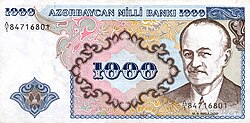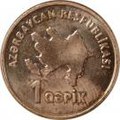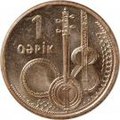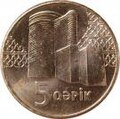Azerbaijani manat
Currency of Azerbaijan From Wikipedia, the free encyclopedia
The manat (ISO code: AZN; sign: ₼; abbreviation: m) is the currency of Azerbaijan. It is subdivided into 100 gapiks.
| Azərbaycan manatı (Azerbaijani) | |||||
|---|---|---|---|---|---|
| |||||
| ISO 4217 | |||||
| Code | AZN (numeric: 944) before 2006: AZM, AYM | ||||
| Subunit | 0.01 | ||||
| Unit | |||||
| Unit | manat | ||||
| Plural | The language(s) of this currency do(es) not have a morphological plural distinction. | ||||
| Symbol | ₼ | ||||
| Denominations | |||||
| Subunit | |||||
| 1⁄100 | Gapik | ||||
| Banknotes | |||||
| Freq. used | ₼1, ₼5, ₼10, ₼20, ₼50, ₼100, ₼200 | ||||
| Rarely used | ₼500 | ||||
| Coins | 1, 3, 5, 10, 20, 50 gapiks | ||||
| Demographics | |||||
| Replaced | Russian ruble[1] | ||||
| User(s) | Azerbaijan | ||||
| Issuance | |||||
| Central bank | Central Bank of Azerbaijan | ||||
| Website | www | ||||
| Valuation | |||||
| Inflation | 8.8%, December 2023 | ||||
| Source | |||||
The first iteration of the currency emerged in the Azerbaijan Democratic Republic and its successor, the Azerbaijan Soviet Socialist Republic, with the issues happening in 1919–1923. The currency underwent hyperinflation, and was eventually substituted by the Transcaucasian ruble, which, in its turn, was converted to the Soviet ruble.
When Azerbaijan gained independence from the Soviet Union, it substituted the Soviet ruble with the manat, which also went through a period of high inflation in the first years, rendering the coinage obsolete. The current manat in circulation exists since the redenomination in 2006, when old manats (AZM) were substituted with lower face values and new design. The currency has mostly been pegged to the US dollar, at what is now the rate of ₼1.70 to US$1.
The Azerbaijani manat symbol was added to Unicode as U+20BC ₼ MANAT SIGN in 2013. A lowercase m was used previously, and may still be encountered when the manat symbol is unavailable.
Etymology
The word "manat" is derived from the Latin word "monēta" and the Russian word "монета" ("moneta") meaning "coin".[2] It was used as the name of the Soviet currency in Azeri (Azerbaijani: манат) and in Turkmen.
First manat, 1919–1923
The Azerbaijan Democratic Republic and its successor, the Azerbaijani Soviet Socialist Republic issued their own currency between 1919 and 1923. The currency was called the manat (منات) in Azerbaijani and the ruble (рубль) in Russian, with the denominations written in both languages (and sometimes also in French) on the banknotes. The manat replaced the first Transcaucasian ruble at par, and was replaced by the second Transcaucasian ruble after Azerbaijan became part of the Transcaucasian Soviet Federal Socialist Republic. No subdivisions were issued, and the currency only existed as banknotes.
Banknotes
The Democratic Republic issued notes in denominations of 25, 50, 100, 250, and 500 manats, whilst the Soviet Socialist Republic issued notes in denominations of 5, 100, 1,000, 5,000, 10,000, 25,000, 50,000, 100,000, 250,000, 1 million, and 5 million manats.
Second manat, 1992–2006
Summarize
Perspective
The second manat was introduced on 15 August 1992.[3] It had the ISO 4217 code AZM and replaced the Russian ruble which itself replaced the Soviet ruble at a rate of RUR 10 to 1 manat.[1]
From early 2002 to early 2005, the exchange rate was fairly stable (varying within a band of 4,770–4,990 manats per US dollar). Starting in the spring of 2005 there was a slight but steady increase in the value of the manat against the US dollar; the reason most likely being the increased flow of petrodollars into the country, together with the generally high price of oil on the world market. At the end of 2005, one dollar was worth 4,591 manats. Banknotes below 100 manats had effectively disappeared by 2005, as had the gapik coins.
Coins

Coins were issued in denominations of 5, 10, 20, and 50 gapiks, dated 1992 and 1993. Although brass and cupronickel were used for some of the 1992 issues, later issues were all in aluminium. These coins were rarely used in circulation.
Banknotes
The following banknotes were issued for this currency
- 1, 5, 10, 250 manats (all first issued on 15 August 1992)
- 50, 100, 500, 1,000 manats (all first issued in early 1993)
- 10,000 manats (first issued in August 1994)
- 50,000 manats (first issued in May 1996)
| Image | Value | Size
(mm) |
Main colours | Description | |||
|---|---|---|---|---|---|---|---|
| Obverse | Reverse | Obverse | Reverse | ||||
 |
 |
1 manat | 125×63 | pink | Maiden Tower in Baku | inscription
«AZƏRBAYCAN MİLLİ BANKI» |
1992 |
 |
 |
yellow, blue | inscription «AZƏRBAYCAN MİLLİ BANKI»
and denomination «BİR manat» |
1993 | |||
 |
 |
5 manats | 125×63 | brown, violet | Maiden Tower in Baku | inscription «AZƏRBAYCAN MİLLİ BANKI»
and denomination «BEŞ manat» |
1993 |
 |
 |
10 manats | 125×63 | brown | Maiden Tower in Baku | надпись
«AZƏRBAYCAN MİLLİ BANKI» |
1992 |
 |
 |
teal | inscription «AZƏRBAYCAN MİLLİ BANKI»
and denomination «ON manat» |
1993 | |||
 |
 |
50 manats | 125×63 | red, grey | Maiden Tower in Baku | inscription «AZƏRBAYCAN MİLLİ BANKI»
and denomination «ƏLLİ manat» |
1993
1999 |
 |
 |
100 manats | 125×63 | pink, blue | Maiden Tower in Baku | inscription «AZƏRBAYCAN MİLLİ BANKI»
and denomination «YÜZ manat» |
1993
1999 |
 |
 |
250 manats | 125×63 | green | Maiden Tower in Baku | inscription
«AZƏRBAYCAN MİLLİ BANKI» |
1992
1999 |
 |
 |
500 manats | 125×63 | brown, blue and orange | Portrait of Nizami Ganjavi | inscription «AZƏRBAYCAN MİLLİ BANKI»
and denomination «BEŞ YÜZ manat» |
1993
1999 |
 |
 |
1,000 manats | 125×63 | brown and blue | Portrait of Mahammad Amin Rasulzade | inscription «AZƏRBAYCAN MİLLİ BANKI»
and denomination «min 1000 manat» |
1993
1999 |
 |
 |
blue | Oil industry theme | inscription «AZƏRBAYCAN MİLLİ BANKI»
and denomination «MİN 1000 manat» |
2001 | ||
 |
 |
10,000 manats | 130×65 | brown | Palace of the Shirvanshahs | inscription «AZƏRBAYCAN MİLLİ BANKI»
and denomination «ON MİN 10 000 manat» |
1994 |
 |
 |
50,000 manats | 132×66 | green | Momine Khatun Mausoleum | inscription «AZƏRBAYCAN MİLLİ BANKI»
and denomination «ƏLLİ MİN 50 000 manat» |
1995 |
Third manat, 2006
Summarize
Perspective
On 1 January 2006, a new manat (ISO 4217 code AZN, also called the "manat (national currency)") was introduced at a ratio of 1 new manat to 5,000 old manats. From 1 October 2005, prices were indicated both in new manats and in old manats to ease the transition. Coins denominated in qəpik, which had not been used from 1993 onward due to inflation, were reintroduced with the re-denomination. The former manat (ISO code 4217 AZM) remained in use through to 31 December 2006.[4]
Symbol
The new banknotes and Azerbaijani manat symbol, ₼, were designed by Robert Kalina in 2006, and the symbol was added to Unicode (U+20BC) in 2013, after failed addition proposals between 2008 and 2011.[5] The final Azerbaijani Manat symbol design was inspired by the design of the Euro sign (€), based on an initial proposal by Mykyta Yevstifeyev,[6] and resembles a single-bar Euro sign rotated 90° clockwise. The manat symbol is displayed to the right of the amount in Azeri and Russian.
Code
The new manat was initially assigned the code AYM on being added to the ISO 4217 standard on 1 June 2005, with an effective date of 1 January 2006.[7] However, this was removed and replaced by AZN on 13 October 2005 as it did not comply with the ISO 4217 currency coding standardization rules (which state that currency codes must begin with the ISO 3166-1 alpha-2 code for the relevant country).[8]
Coins
Coins in circulation are 1, 3, 5, 10, 20 and 50 gapiks. Most coins closely resemble the size and shape of various euro coins. Most notably the bimetallic 50 gapik (similar to the €2 coin) and the 10 gapik (Spanish flower, like the 20 euro cent coin). Coins were first put into circulation during January 2006 and do not feature a mint year.
| Image | Value | Technical parameters | Description | |||||
|---|---|---|---|---|---|---|---|---|
| Obverse | Reverse | Diameter | Mass | Composition | Edge | Obverse | Reverse | |
 |
 |
1 gapik | 16.25 mm | 2.8 g | Copper-plated steel | Plain | Map of Azerbaijan, country name, value | Traditional musical instruments, denomination left |
 |
 |
3 gapiks | 18 mm | 3.45 g | Smooth with a groove | Books and quill, denomination above | ||
 |
 |
5 gapiks | 19.75 mm | 4.85 g | Reeded | The Maiden Tower, denomination below | ||
 |
 |
10 gapiks | 22.25 mm | 5.1 g | Brass-plated steel | Smooth with seven indentations | Military helmet of the region of Nagorno-Karabakh, denomination left | |
 |
 |
20 gapiks | 24.25 mm | 6.6 g | Segmented reeding | Spiral staircase, Geometry & Geometrical symbols, denomination left | ||
 |
 |
50 gapiks | 25.5 mm | 7.7 g | Bi-Metallic Brass-plated steel center in Stainless Steel ring | Reeding over lettering (AZƏRBAYCAN RESPUBLIKASI) | Two oil wells, denomination left | |
Banknotes
Banknotes in circulation are ₼1, ₼5, ₼10, ₼20, ₼50, ₼100, ₼200, and ₼500. They were designed by Austrian banknote designer Robert Kalina, who also designed the current banknotes of the euro and the Syrian pound. The notes look quite similar to those of the euro, and the choice of motifs was inspired by the euro banknotes.
In 2009, the Azərbaycan Milli Bankı (National Bank of Azerbaijan) was renamed the Azərbaycan Respublikasının Mərkəzi Bankı (Central Bank of Azerbaijan). In 2010, the ₼1 banknote was issued with the new name of the issuing bank, in 2012 a ₼5 banknote was issued with the new name of the issuing bank and in 2017 a 100₼ banknote dated 2013 was issued with the new name of the issuing bank.
In 2011 Azerbaijan's Ministry of Finance announced it was considering issuing notes of ₼2 and ₼3 as well as notes with values larger than ₼100.[9] In February 2013, the Central Bank of Azerbaijan announced it would not introduce larger denomination notes until at least 2014.[10]
In 2018, a ₼200 banknote was issued to commemorate Heydar Aliyev's 95th birthday.[11]
Redesigned ₼1, ₼5, and ₼50 banknotes were introduced in 2021, preserving the same motifs but with updated designs.[12] These circulate in parallel with existing notes.
A new commemorative ₼500 banknote was introduced in 2021.[13]
2005 series
| Image | Value | Dimensions | Main Color | Description | Year | ||
|---|---|---|---|---|---|---|---|
| Obverse | Reverse | Obverse | Reverse | ||||
 |
 |
₼1 | 120 × 70 mm | Grey | Theme: Culture Azerbaijani folk music instruments (daf, kamancheh, tar) |
Ornaments of regional carpets | 2005 |
 |
 |
2009, 2017 | |||||
 |
 |
₼5 | 127 × 70 mm | Orange | Theme: Writing and literature Writers, poets, and books from Azerbaijan, with a written excerpt of the national anthem (Namusunu hifz etmeyə, Bayrağını yükseltməyə, Çümlə gənclər müştaqdır! Şanlı Vətən! Şanlı Vətən! Azərbaycan! Azərbaycan!) and letters from the contemporary Azerbaijani alphabet (ə, ö, ğ, ş) |
Rock drawings of Gobustan, samples of Old Turkic script | 2005 |
 |
 |
2009, 2017 | |||||
 |
 |
₼10 | 134 × 70 mm | Teal | Theme: History Old Baku, the Palace of the Shirvanshahs and the Maiden Tower against a background of the Icheri Sheher wall |
Ornaments of regional carpets | 2005 |
 |
 |
2018 | |||||
 |
 |
₼20 | 141 × 70 mm | Green | Theme: Karabakh Signs of power (a sword, a helmet and a shield) |
Symbol of peace (harybulbul) | 2005 |
 |
 |
₼50 | 148 × 70 mm | Yellow | Theme: History and future Youth, stairs (as a symbol of progress), the sun (as a symbol of force and light) and chemical and mathematical symbols (as signs of science) |
Ornaments of regional carpets | 2005 |
 |
 |
₼100 | 155 × 70 mm | Mauve | Theme: Economy and development Architectural symbols from antiquity up to today, the manat currency symbol (₼) and symbols of economic growth |
Ornaments of regional carpets | 2005 |
 |
 |
2013 | |||||
 |
 |
₼200 | 160 × 70 mm | Blue | Theme: Modern architecture The Heydar Aliyev Center, Baku |
Ornaments of regional carpets | 2018 |
2020 refurbishment
| Image | Value | Dimensions | Main Color | Description | Year | ||
|---|---|---|---|---|---|---|---|
| Obverse | Reverse | Obverse | Reverse | ||||
 |
 |
₼1 | 120 × 70 mm | Grey | Theme: Culture Azerbaijani folk music instruments (daf, kamancheh, tar) |
Map of Azerbaijan | 2020 |
 |
 |
₼5 | 127 × 70 mm | Orange | Theme: Writing and literature Writers, poets, and books from Azerbaijan, with the lyrics of the full Azərbaycan marşı | ||
 |
₼10 | 134 × 70 mm | Teal | Theme: History
Old Baku, the Palace of the Shirvanshahs and the Maiden Tower against a background of the Icheri Sheher wall |
2022 | ||
 |
 |
₼20 | 141 × 70 mm | Green | Theme: Karabakh Signs of power (a sword, a helmet and a shield) |
2022 | |
 |
 |
₼50 | 148 × 70 mm | Yellow and brown | Theme: History and future Youth, stairs (as a symbol of progress), the sun (as a symbol of force and light) and chemical and mathematical symbols (as signs of science) |
2020 | |
 |
 |
₼500
(commemorative) |
165 × 70 mm | Brown, red, green and blue | Theme: The 2020 Karabakh War |
Mausoleum of Molla Panah Vagif; Askeran fortress | 2021 |
Exchange rates
- Before Feb 2015: US$1 = ₼0.78
- Feb - Dec 2015: US$1 = ₼1.05
- Dec 2015 - Apr 2017: Fluctuate
- May 2017 onwards: US$1 = ₼1.7 (pegged)
See also
References
External links
Wikiwand - on
Seamless Wikipedia browsing. On steroids.

